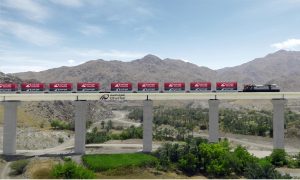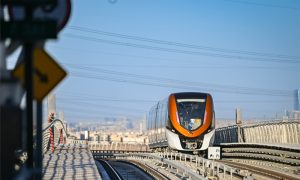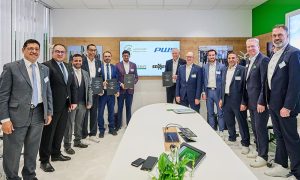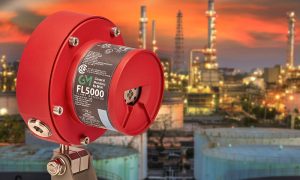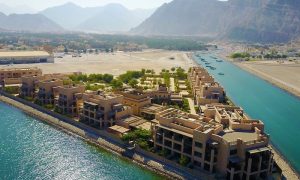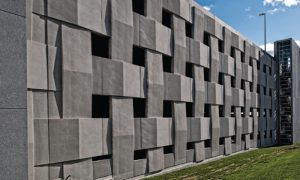Tunnel boring machines making a name in the Middle East
Industry professionals on the regional tunnel boring challenges

A tunnel boring machine (TBM) cannot begin work on a new project until it has been given a name, according to tunnelling tradition. This is practised throughout the world as a sign of good luck for the project ahead.
The Middle East is set to name many TBMs, as the region is quickly becoming a key market for tunnelling and drilling equipment – underground infrastructure is a growing industry, according to a 2015 report by the International Quality and Productivity Centre (IQPC). As the region continues to expand rapidly, in addition to development and urbanisation schemes, key cities are becoming congested and infrastructure construction is increasing.
According to the IQPC, the UAE in particular is a critical driver of the industry’s growth, aiming to spend approximately $329 billion on a variety of national infrastructure and urban construction projects over the coming 15 years. Furthermore, the report claims that in 2013, the global tunnelling and drilling equipment market was valued at $16.5 billion with a CAGR rate of 4.86% from 2009-2013, noting specifically that Asia Pacific remains the largest regional market. In order to meet the increasing demand on the existing infrastructure, in addition to addressing spatial limitations in developed cities and population growth, sustainable and energy-efficient cities have become a necessity. This has led to the construction of below-ground facilities like tunnels and underpasses.
Throughout the Middle East, the technical requirement for the use of tunnels for major infrastructure schemes is becoming more apparent, resulting in almost $300 billion being spent on proposed rail and water projects. These projects include the Riyadh Metro, the Makkah Metro, Dammam Metro, the Dubai Metro Extension, the Abu Dhabi Metro, Etihad Rail Phase 3 Extension, Oman National Railway project and the Dubai Strategic Sewerage Tunnels, to name just a few.
As these mega projects get underway, CMME caught up with two industry professionals to discuss the challenges and opportunities facing the variety of operations conducted by tunnel boring machines in the Middle East.
Dr Kamiran Ibrahim, Water global business leader at Arcadis Middle East, shares his thoughts on how ground conditions influence the projects undertaken, and how his team works to predict and overcome problems facing TBMs.
“The construction of projects with tunnelling components is challenging due to the risks involved, which need to be properly managed and mitigated prior to the project inception,” he says. “One of the major risks and important factors to consider is the specific ground conditions or the geological uncertainties of the site.”
Focusing on projects in this region, Ibrahim notes there are various types of TBM, with usage depending on ground conditions. For example, depending on the strength of the material to be excavated, unshielded or shielded TBMs could be used.
“Unshielded TBMs are to be used when excavating in rock with good to very good condition that can support itself without imposing any danger to the working personnel until the primary support system is installed. For ground conditions, like soil or weak rocks, that the medium cannot self-sustain the excavated opening, then shielded TBMs are used, in addition to tunnel support.”
Challenges continue to present themselves once the TBM is underground. “We do our investigation beforehand, testing and drilling bore holes to minimise surprises, but even with the best will in the world, sometimes you get these surprises where you find something you were not expecting. These can include particles within the soil and boulders in the ground, for example.”
“You can tell from the progress of the drilling if there’s a problem. We do have sensors installed on the machine to provide updates for the alignment, so there’s always someone monitoring, supervising and watching that data.”
The IQPC details a number of challenging geological features and environments in the UAE which further necessitate the use of advanced TBM technologies and techniques. The report highlights that under much of the UAE are conglomerates of slumped and redeposited shelf limestones or karstic limestone formations. Furthermore, water has passed through the ground layers, wearing away rock and creating cavities. The presence of these particular ground formations frequently requires advanced soft-ground TBMs, also known as slurry machines, with variable density boring drills.
Detlef Jordan, sales manager for Europe, Turkey and Middle East at The Robbins Company, goes on to discuss the drastic changes in TBM technology that allows TBMs to be used more widely across a much greater range of ground conditions.
“As little as 10 years ago, people would say, ‘No way, you can’t use a TBM on these ground conditions, it’s too fractured, and too weak, the risk of collapse is too high.’ However, in recent history, more and more we’ve learned that customers require machines that are flexible to cope with various ground conditions.”
Jordan describes the tunnelling process as a conversation with the ground, assessing permanent feedback and reacting to the performance of the machine. This process has improved a lot in recent years, he claims, with the advancement of ground condition prediction techniques.
“We can take readings about the ground conditions. We use methods including measuring systems and instruments and techniques to read the rock conditions, feeding information to computers. This allows us to read and analyse what’s coming next. The situation has improved greatly, so now people use TBMs on certain projects that once we wouldn’t dare to.”
Jordan highlights a specific example in Turkey, a railway line near Antalya consisting of twin tunnels, a total of 20km of tunnelling underground in total. Due to the nature of the rock formation in the location, the TBM is required to cope with different loads – therefore a universal TBM is needed, capable of drilling soft and hard rock formations.
This requires a hybrid machine known as a cross-over, Jordan explains, because they cross soft and hard machine types and are capable of operating in a range of geological conditions, including hard rock, soft ground, abrasive basalt, watery clays and boulders. As far as the trend towards cross-over TBMs goes, Jordan suggests that the majority of recent projects call for such machines, including Middle East projects such as the Doha Metro.
Considering the new demands being placed on TBMs, how has the manufacturing process developed to keep pace with project requirements?
Ibrahim discusses the early phases of new tunnelling projects, suggesting that tunnel projects to be excavated by TBMs are most frequently awarded in the form of design and build contracts. Following the completion of the geotechnical investigation and the geotechnical interpretation report, some first conclusions are drawn by the design consultant and the first recommendations to the contractor regarding the machine to be used are made.
Information used to determine TBM requirements includes geology, the tunnel alignment, site restrictions, presence of critical structures and experienced and local knowledge of the buyer. The contractor contacts a TBM manufacturer, provides the project’s requirements and specifications, and the available geotechnical data and design and construction of the TBM is done by the TBM manufacturer.
“The TBM delivery time depends a lot on the knowledge of the sub-surface conditions that will be expected. The earlier the interactions between ground conditions, site constraints and tunnelling method in the entire system are known and considered, the sooner the delivery of the TBM, which can be within six to twelve months. It is also worth noting that the shipment of the TBM to site and its assembly can also vary between two to four months.”
Jordan proceeds to highlight the technological developments in the field of tunnel boring that will contribute to the success of upcoming projects.
“Methods and means of ground prediction are a critical factor,” he says. “Looking ahead and planning in advance, to obtain more realistic and accurate information about the ground conditions that the TBMs are facing, is a key area for development. This is always important, because it is always advisable and always necessary to know what is coming ahead.”
Jordan adds an example from a UK company seeking to pioneer new developments in this field. “They wanted to develop horizontal drilling, instead of vertical drilling ahead of the machine. This represents some intelligent drilling systems which could really benefit the TBM project – actually drilling parallel to the machine drilling, gathering ground prediction data. This type of thinking can assist with planning ahead, utilising technology such as radars to acquire sophisticated readings of rock.”
He notes that there is space for development here; contractors always need to know what is ahead. “Reality doesn’t always reflect the best produced report – we can never be 100% certain in what we predict to encounter in TBM drilling.”
Considering the scope of projects either underway or pending in the Middle East region, the demand for TBMs will continue, and technological advancements will assist in ever-greater accuracy and efficiency on site, says Jordan
Ibrahim concludes by acknowledging the huge opportunity for business and machines as far as tunnels go in the region. “I have to say, across the board we are seeing demand rising. If I had to say which countries specifically, I would point to Qatar and KSA for their exceptional growth.”
Jordan highlights extensive current infrastructure operations in Turkey, which he calls a “steadily developing market”.
“For us it is one of the most important things, infrastructure. Many of these projects occur underground – it is not wished anymore to have such things above ground. Landscapes often prevent surface infrastructure too, forcing project operations underground. Infrastructure is receiving significant government and private sector attention throughout the region; we’re seeing big projects in railroad, water, waste and hydro power too.”
Due to the vast scale and ambitious designs involved in many Middle East construction and infrastructure projects, it is essential to secure the most reliable foundation structures in order to ensure durability and resilience in underground operations, states the IQPC report. A number of challenging geological features and environments will further necessitate the use of advanced construction technologies and techniques, especially in the field of assessing and investigating ground conditions, an already sophisticated area of TBM operations which manufacturers are ready to further develop.
The numbers
$329 billion: Spending on national infrastructure and urban construction projects in the UAE over the coming 15 years
$16.5 billion: Value of the global tunnelling and drilling equipment market in 2013
$300 billion: Current Middle East spending on tunnels for major infrastructure schemes
Tunnel Boring Projects in Abu Dhabi
Of the numerous large-scale underground infrastructure projects underway at present in the UAE, the Abu Dhabi Strategic Tunnel Enhancement Programme (STEP) project is noteworthy for the ambitious nature of the tunnel boring operations. Featuring 84km of sewage collection tunnels leading to treatment plants in Al Wathba, the system has involved the construction of a 41km-deep sewer tunnel, supported by 43km of supply tunnels which are smaller in diameter and designed to carry the wastewater away to the treatment plants.
The project was initiated in 2009, and is estimated to be completed in early 2016, with total project investment value topping $1.5 billion. One of the main challenges of this project was to achieve the proper sloping depth required to allow gravity to efficiently carry the wastewater, says an IQPC report on underground infrastructure projects in the UAE.
In order to make this a reality, the use of advanced TBMs were required in order to reach a sloping depth starting at approximately 27m and reaching deeper than 100m. Three TBMs have been deployed for the various construction phases of the project. Once completed, the Abu Dhabi Sewerage Services Company’s capacity to handle wastewater will almost double, from 450,000m3 to over 80,000m3.
Underground Infrastructure Projects in Dubai
The Dubai Godolphin Road Improvement Project, valued at $272 million, involves the construction of roads, bridges and tunnels linking to parallel roads, to ease the pressure on commuters and provide entry and exit points for Sheikh Zayed Road.
With a project initiation date in November 2014 and an estimated project completion date in mid-2017, the aim is to support the existing roads in the Business Bay district, improving traffic services and providing entry and exit options for the area stretching along the Sheikh Zayed Road, while linking up with the surrounding communities.
Where possible, the UAE prefers the use of tunnel boring machines, according to data gathered by the IQPC. The reason behind this preference is to create tunnelling and underpasses that minimise the disruption to the city’s inhabitants and traffic flow.
